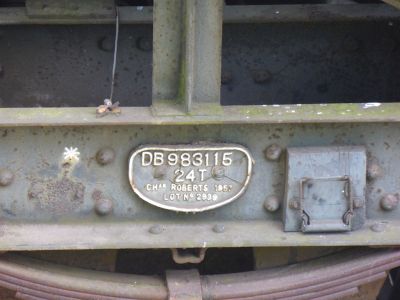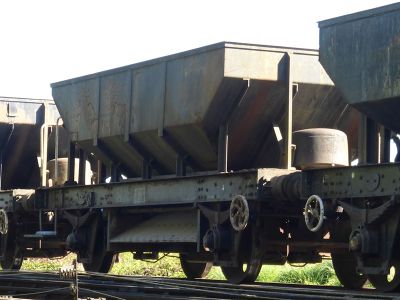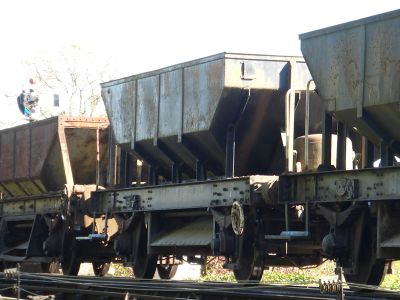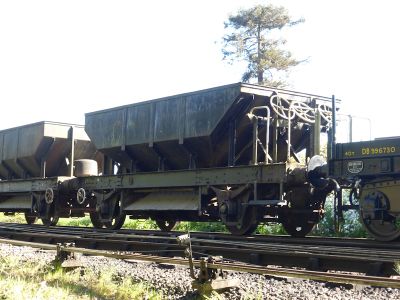BR 'Dogfish' Ballast Hopper Wagons
| BR 'Dogfish' Ballast Hopper Wagons | |
|---|---|
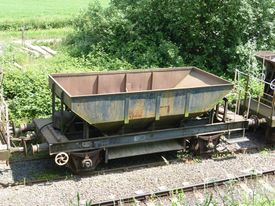 BR Dogfish DB983115 at Eardington, June 2018 | |
| Built By | Chas Roberts (Wakefield) |
| Status | Operational |
| Number | DB983115 |
| History | |
| Built | 1957 |
| Diagram | 1/587 |
| Lot | 2939 |
| Type | 4-wheel ballast hopper |
| Capacity | 24 tons |
| Telegraphic code | DOGFISH |
| TOPS code | ZFV |
| Brakes | Vacuum fitted, air through pipe (2022) |
| 1996 | Arrived on SVR |
Contents
DOGFISH ballast wagons
In 1955 BR adopted the 19-ton CATFISH as its first standard vacuum-fitted small steel ballast hopper wagon design. This had a single bottom door which only allowed stone discharge between the rails.[1] The 24-ton DOGFISH, which was introduced in the following year, was an enlarged version which was several inches taller and was fitted with both centre and side doors, allowing ballast to be dropped to either side of the rails as well as between them. The doors on the latter type were operated from three control wheels on a platform at one end of the wagon. The vacuum cylinder was mounted on the platform at the opposite end, next to which a hand wheel on the side of the wagon controlled the parking brake. The 4-wheel chassis had a 14 ft wheelbase and measured 22ft 6in over the headstocks.[2]
The DOGFISH was the most numerous four-wheeled ballast hopper built for BR, with a total of 1,249 completed under Diagram 1/587 in ten Lots between 1956 and 1959. Of those, Metro-Cammell built 559 in four Lots and Chas Roberts of Wakefield built 548 in three Lots (all three of the SR's examples were built by Chas Roberts). The final 142 wagons were built in three Lots by BR at Shildon. [3] All were vacuum fitted; there were certain design changes during construction although these did not warrant a new Diagram number. In particular, early examples had oil axle boxes while later examples came with OLEO buffers and roller bearings; those intended for BR's Southern region were also fitted with longer side chutes to clear the third rail.[2].
In service they carried a variety of different liveries, beginning with all over Black, then 'Gulf Red' from 1960 to 1962. Olive green was used from around 1966 and grey from around 1983.
BR Civil Engineers' wagons were commonly given 'fish' telegraph codes, with Dogfish being a general name describing various small sharks.[2]. When TOPS codes were introduced in the late 1960s they were allocated the code ZFV.
Service and Preservation
Details of the 3 Hopper Wagons are as follows:
| Number | Built | Built by | Lot | Wagon Survey | Notes |
|---|---|---|---|---|---|
| 983115 | 1957 | Chas Roberts | 2939 | Link | Still resident |
| 983194 | 1957 | Chas Roberts | 2939 | Link | Left 2018 |
| 993126 | 1956 | Chas Roberts | 2821 | Link | Left 2018 |
DB983115 was built in 1957 and initially allocated to Llynclys Junction (Llandu Quarries).[2]
Following the closure of the Burton Wagon Repair Department, DB 983115 arrived on the SVR by road on 2 December 1996 having been selected for preservation by then-P. Way Department Supervisor Gerry Carter and purchased by Bridgnorth C&W member John Briscoe.[4] MERMAID DB989098 was also acquired from Burton in the same manner and arrived the following day. Both were immediately put into use on Engineers' P-Way trains.[5]
Two further DOGFISH were later acquired by the SVR for the same purpose.[note 1] These were DB983194 (initially allocated to Batts Combe Quarry, Cheddar on the Western Region)[2] and DB993126. The three photographs below show all three wagons in a ballast train at Bewdley in April 2015.
In 2017 SVR(H) acquired six SEACOW 40T ballast hoppers (five operational plus one spare). These were both larger than the DOGFISH and air-braked, potentially rendering the DOGFISH surplus to requirements. In January 2018 it was reported that two of the three had been sold/transferred to the Swanage Railway. The remaining privately-owned wagon, 983115, was photographed at Eardington in June 2018. In December 2022 it was fitted with a through pipe for air braking at Kidderminster Carriage Repair Works.
See also
Notes
- ↑ The date of arrival and prior history of the other two DOGFISH is uncertain. They were not listed in the 1998 Stock Book, but were photographed in use on the SVR from around 2011 onwards.
References
- ↑ Larkin Vol 1 (2011), p.4.
- ↑ 2.0 2.1 2.2 2.3 2.4 Larkin Vol 1 (2011), pp.36-37.
- ↑ Rowland 1985), Appendix.4.
- ↑ SVR News 122
- ↑ SVR Stock Book Ninth Edition
Links
- LTSV Wagons: ZEV 'Catfish'/ZFV 'Dogfish' Ballast Hoppers
- Swanage Railway Rolling Stock - Public View (includes further information on the two Dogfish)
